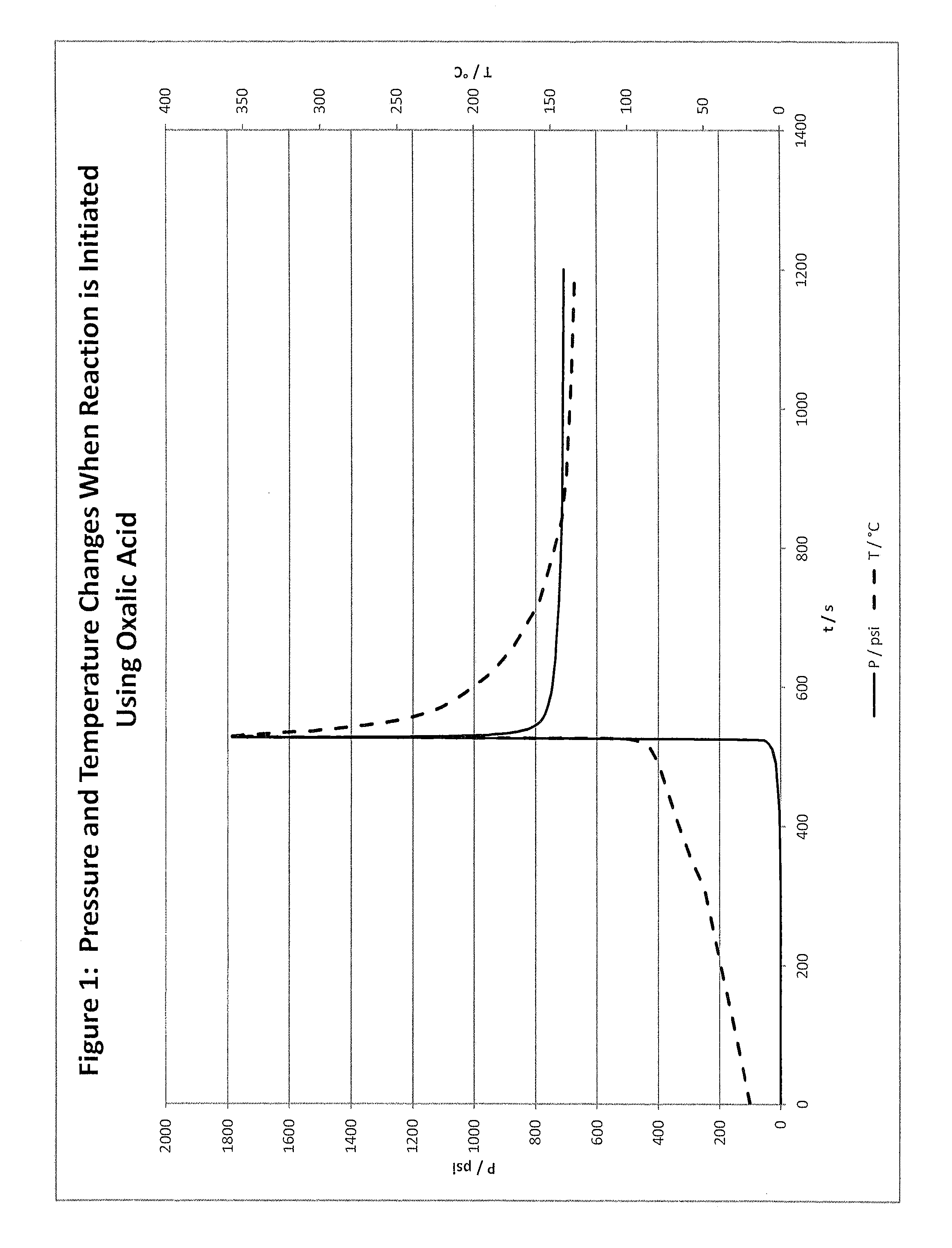Hydrocarbon stimulation by energetic chemistry
- Summary
- Abstract
- Description
- Claims
- Application Information
AI Technical Summary
Benefits of technology
Problems solved by technology
Method used
Image
Examples
example 1
Variation of the Carboxylic Acid
[0034]18.5 g (0.231 mol) of ammonium nitrate was placed into a beaker; 17.05 g (0.95 mol) de-ionized water, 0.075 g (0.0007 mol) sodium carbonate, 0.15 g (0.0019 mol) pyridine, and 11.83 g (0.17 mol) sodium nitrite were added. The mixture was stirred on a magnetic stirrer until all solids were dissolved. The buffered reactive solution was added to the micro reactor vessel.
[0035]The reaction was initiated by lowering the pH from pH 7 to lower than pH 6. To enable an in-situ release of the acid inside the reactive solution, an encapsulated acid or a special release device could be used. Both methods allow the release of the acid at a certain temperature range, which depends on the properties of the release agent. To obtain the results below, a wax release device was used, which melted and released the acid as the system heated up.
[0036]2 g of the organic acid (oxalic, citric or acetic) was placed into a wax release device and covered with 1 g of de-ioni...
example 2
Effect of Initial Carboxylic Acid Concentration
[0037]18.5 g (0.231 mol) of ammonium nitrate was placed into a beaker; 17.05 g (0.95 mol) de-ionized water, 0.075 g (0.0007 mol) sodium carbonate, 0.15 g (0.0019 mol) pyridine, and 11.83 g (0.17 mol) sodium nitrite were added. The mixture was stirred on a magnetic stirrer until all solids were dissolved. The reactive solution was added to the micro reactor vessel.
[0038]The reaction was initiated by lowering the pH from pH 7, to lower than pH 6. To enable an in-situ release of the acid inside the reactive solution, an encapsulated acid or a special release device could be used. Both methods allow the release of the acid at a certain temperature range, which depends on the properties of the release agent.
[0039]The organic acid was placed into a wax release device and covered with 1 g of de-ionized water. The filled release device was placed gently inside the bottom part of the micro reactor vessel and all valves were closed. The reaction ...
example 3
Effect of Reagent Ratios (Excess Ammonium Nitrate) in Varying Carboxylic Acids
[0040]Either 18.5 g (0.231 mol) or 14.84 g (0.185 mol) of ammonium nitrate was placed into a beaker; 17.05 g (0.95 mol) de-ionized water, 0.075 g (0.0007 mol) sodium carbonate, 0.15 g (0.0019 mol) pyridine, and 11.83 g (0.17 mol) sodium nitrite were added. The mixture was stirred on a magnetic stirrer until all solids were dissolved. The reactive solution was added to the micro reactor vessel,
[0041]The reaction was initiated by lowering the pH from pH 7 to lower than pH 6. To enable an in-situ release of the acid inside the reactive solution an encapsulated acid or a special release device could be used. Both methods allow the release of the acid at a certain temperature range, which depends on the properties of the release agent.
[0042]The organic acid was placed into a wax release device and covered with 1 g of de-ionized water. The filled release device was placed gently inside the bottom part of the mic...
PUM
 Login to View More
Login to View More Abstract
Description
Claims
Application Information
 Login to View More
Login to View More - R&D
- Intellectual Property
- Life Sciences
- Materials
- Tech Scout
- Unparalleled Data Quality
- Higher Quality Content
- 60% Fewer Hallucinations
Browse by: Latest US Patents, China's latest patents, Technical Efficacy Thesaurus, Application Domain, Technology Topic, Popular Technical Reports.
© 2025 PatSnap. All rights reserved.Legal|Privacy policy|Modern Slavery Act Transparency Statement|Sitemap|About US| Contact US: help@patsnap.com



